A Smart Guide to Volunteer Recruitment: 17 Proven Strategies
Nonprofits of all shapes and sizes rely on volunteers to continue fulfilling their mission day after day. Whether they’re helping shelter animals find their forever homes or setting up fundraising events, volunteers provide their time and skills to amplify your organization’s impact.
In its latest Value of Volunteer Time report, Independent Sector estimates that each U.S. volunteer’s hour is worth $33.49. To secure such valuable support for your nonprofit, however, you’ll need a clear strategy for how to recruit volunteers.
In this guide, we’ll walk through the fundamentals of volunteer recruitment and provide effective strategies to boost your results:
- Volunteer Recruitment: FAQs
- How to Recruit Volunteers: 5 Steps
- 17 Volunteer Recruitment Strategies for Success
With the right approach, you’ll be able to recruit dedicated supporters to further your mission. Let’s get started!
Volunteer Recruitment: FAQs
Before your organization starts crafting its own volunteer recruitment plan, it’s essential to first understand the basics of the process. Let’s explore a few frequently asked questions to break down how to recruit volunteers for your nonprofit.
What is volunteer recruitment?
Volunteer recruitment is the process of attracting new volunteers to support your nonprofit’s work in a variety of ways, from fundraising to advocating for your cause. Since there are so many organizations calling for volunteers in emails, social media posts, and even text messages, it’s critical to figure out how you’ll stand out from the crowd.
The ideal candidates for your nonprofit’s volunteer program are passionate about your mission and committed to making a difference in the lives of those you serve. By optimizing your volunteer recruitment efforts, you’ll be able to build a strong volunteer base to power your organization’s impact.
Why is volunteer recruitment important?
Volunteers are vital to your nonprofit’s ability to fulfill its mission. Therefore, volunteer recruitment is crucial for acquiring the support that will ensure your long-term success. Most notably, volunteers benefit your organization by:
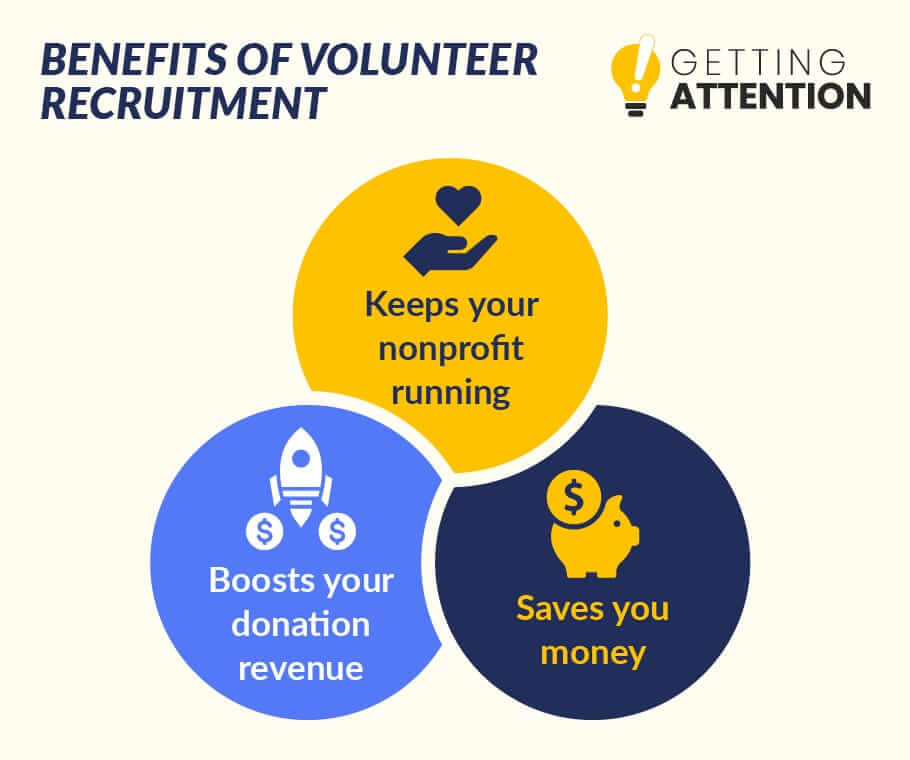
- Keeping it running. By offering their time and skills for free, your committed volunteers provide a significant resource that helps your nonprofit move forward with its mission.
- Increasing your donation revenue. Volunteers can not only spread the word about your nonprofit’s mission to their personal networks, but they can also become donors themselves due to their dedication to your cause.
- Saving you money. AmeriCorps found that, between September 2020 and 2021, “volunteers served an estimated 4.1 billion hours with an economic value of $122.9 billion.” Since time is money, free support from volunteers can go a long way toward reducing your nonprofit’s administrative and operational expenses.
Take a look at your nonprofit’s current state and evaluate how volunteers are facilitating or enhancing your results. These insights can guide you in determining how to recruit more volunteers for your organization.
Do I need a volunteer recruitment plan?
A volunteer recruitment plan is critical to securing as much support for your nonprofit as possible. After all, 72% of volunteers are involved with only one organization, while just 18.3% volunteer with two.
Having an organized, evidence-based approach to recruiting volunteers ensures that you catch the attention of potential supporters and inspire them to get involved.
How to Recruit Volunteers: 5 Steps
Fortunately, it only takes five steps to craft a successful volunteer recruitment plan:
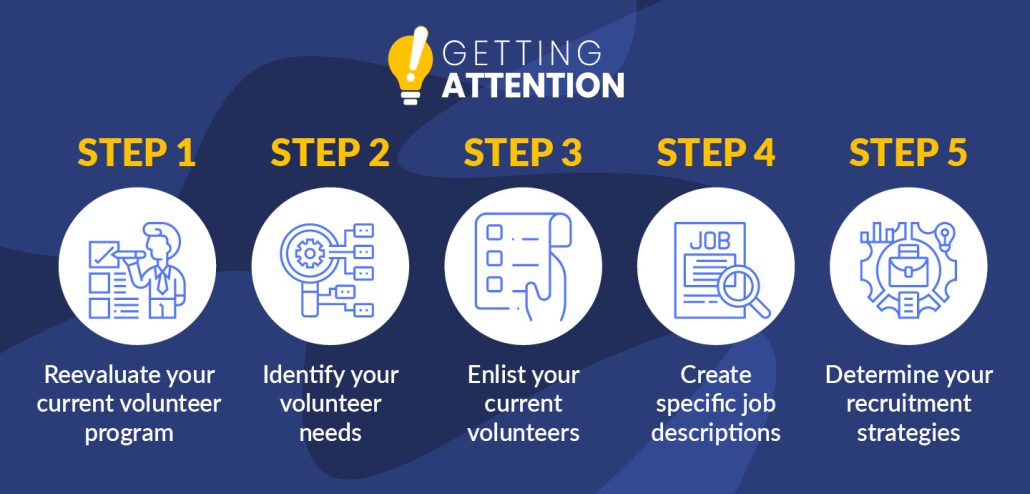
1. Reevaluate your current volunteer program.
Start by inspecting your current volunteer program. In order to motivate people to join, your program must:
- Be engaging. Is your volunteer program interactive? Are there opportunities to connect with staff and other volunteers? Your volunteers should be able to get up close and personal with your nonprofit’s work so that they can feel like they’re making a real difference in their community.
- Emphasize impact. Make sure your volunteers understand exactly how they’re contributing to your nonprofit’s impact. The more they feel like they’re making a positive difference, the more likely they are to stay invested in volunteering.
- Factor in appreciation. It’s important to have plans in place to make your volunteers feel valued. There are many ways to express your nonprofit’s gratitude, including a thank-you email, e-Card, a social media shoutout, or even a handwritten letter.
While you can evaluate your current volunteer program on your own, consider surveying your existing volunteers as well. They have firsthand experience with your program and may provide a useful outside perspective. Plus, asking your volunteers for feedback demonstrates that you care about their opinions and preferences.
2. Identify your volunteer needs.
After you’ve determined your volunteer program’s strengths and areas for improvement, it’s time to identify the types of volunteers you need most. Use these questions to guide you:
- What type of organization are we? Many people choose to volunteer for organizations that align with their interests, skills, and passions. Reflecting upon your nonprofit and its mission allows you to appeal to individuals who are most likely to contribute to your cause.
- What type of volunteer program do we offer? There are various types of nonprofit volunteer programs, including formal, non-formal, and project-based. Defining this upfront ensures that you can focus on attracting supporters who will be interested in your specific type of program.
- How many people do we need? Do you need one person to volunteer regularly? 10 people to volunteer every week in shifts? 100 volunteers for a specific event? The number of volunteers each organization needs will differ, so determine what suits your nonprofit best.
Identify what sets your volunteer program apart from others, and highlight these differences in your nonprofit communications to attract the most suitable volunteer candidates.
3. Enlist your current volunteers.
Your nonprofit’s most dedicated volunteers can be an excellent volunteer recruitment tool. Encourage them to reach out to like-minded friends and family members about joining your volunteer program. You can even invite them to bring someone along to their next volunteer shift to show them the ropes and spark their interest.
Consider offering benefits such as free branded merchandise or social media shoutouts to further incentivize your current volunteers to spread the word. This will not only bolster your recruitment efforts but also help you retain more supporters in the long run.
4. Create specific job descriptions.
The success of your nonprofit’s volunteer program depends on how well you communicate with volunteers. Therefore, when recruiting volunteers, it’s essential to get specific with the job description you create for each role. This way, you’ll be able to find volunteers with the right skillsets, and those who are interested in volunteering can easily determine whether a role is suitable for them.
Some popular volunteer roles may deal with:
- Graphic design
- Photography
- Writing
- Translation
- Event check-in
- Event planning
- Event setup and cleanup
- Fundraising
Be sure to include the relevant skills for each volunteer role to maximize your recruitment effort and narrow down candidates to the best fit. Potential volunteers will also want to know important details such as the role’s time commitment, duties, and any associated benefits in advance. Use the template below to hit the ground running with well-written volunteer job descriptions for your nonprofit.
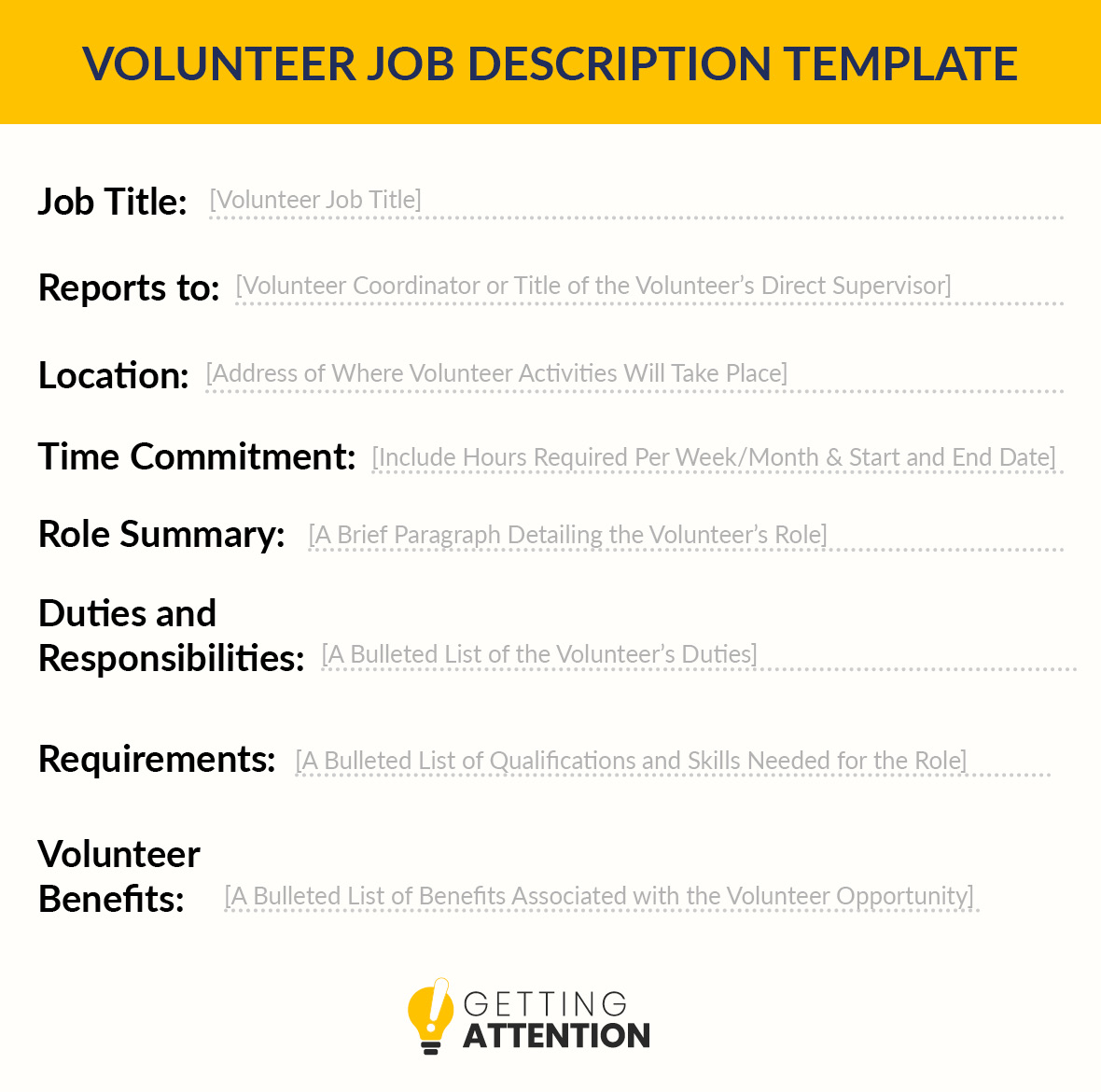
5. Determine your recruitment strategies.
Once you’ve solidified your volunteer program’s needs and identified the specific roles you’re looking for, you’re ready to start implementing recruitment strategies to secure new support for your nonprofit.
While there are numerous strategies for how to recruit volunteers, the ones you choose to focus on will depend upon your organization’s unique goals and resources. Let’s explore impactful volunteer recruitment strategies to consider.
Volunteer Recruitment Strategies for Success
Use these volunteer recruitment strategies as a jumping-off point for your nonprofit:
1. Leverage social media.
Social media is a powerful and cost-effective way to reach a broader audience. Get creative with your Facebook, Instagram, and Twitter pages to show potential volunteers how rewarding it is to support your organization.
For instance, you can promote your volunteer program on social media by:
- Going “behind the scenes.” Share videos or images that offer a glimpse into your nonprofit’s on-the-ground impact to show potential supporters the meaningful work they can participate in as a volunteer.
- Posting volunteer testimonials. Capture some compelling action shots of your volunteers and ask them to provide a quote about why they love what they do. Then, with their permission, share their picture and quote on social media to inspire others to volunteer.
- Letting volunteers do an account “takeover.” This allows potential supporters to learn more about a day in the life of one of your volunteers and how important their contributions are to your overall impact.
- Creating social media ads. By investing in a paid volunteer recruitment ad campaign, you can target more people who are likely to be interested in your nonprofit’s opportunities by focusing on characteristics such as location, interests, and connections.
With 4.76 billion social media users worldwide, sharing your volunteer opportunities on these platforms can not only recruit more support for your nonprofit but increase your brand awareness as well. Be sure to include a link to your volunteer application form on each of your posts to make it easy for inspired users to get involved.
2. Advertise volunteer opportunities online.
By advertising your nonprofit’s volunteer opportunities online, you ensure that potential volunteers can learn about your open positions and explore all the relevant details to start contributing.
The Google Ad Grants program provides an impactful, cost-effective way for nonprofits to advertise their volunteer opportunities. This program awards eligible nonprofits $10,000 a month in ad credits, which they can spend on relevant keywords. Then, they can create text-based ads to promote their content at the top of Google’s search results.
A link to The Nature Conservancy’s volunteer page, for instance, pops up in the search results when a user searches “nature volunteering,” directing those who are interested to learn more about getting involved.

Your nonprofit can take a similar approach to volunteer recruitment, using this grant to target potential volunteers with advertisements of your open positions or volunteer page.
If you’re interested in getting started with the Google Ad Grant program and maximizing your results, consider partnering with a certified agency, like Getting Attention. We’ll determine your eligibility for the program, handle your application, and craft a winning strategy to help your organization secure more support—so you can focus on generating a greater impact on those you serve.
3. Approach recent donors.
Your nonprofit’s donors have already demonstrated an investment in your mission by making a gift to your organization. When you follow up with first-time donors and thank them for their contribution, be sure to let them know about other ways to get involved, such as volunteering. One-time donors who may not have the financial means to donate consistently may prefer giving their time instead.
AmeriCorps notes that, behind teenagers, people between the ages of 45 to 54 have the highest formal volunteering rate. With this in mind, consider segmenting your donor database and reaching out to this group, among others, who would be most likely to participate in a volunteer program.
4. Cultivate corporate partnerships.
Corporate philanthropy is another excellent avenue for volunteer recruitment. By reaching out and nurturing relationships with businesses, you can open the door for them to support your nonprofit in several ways. For example, they may encourage their employees to volunteer with your organization or even arrange mandatory team volunteer activities.
Many businesses support nonprofits and encourage employee volunteering through volunteer grants. With 40% of Fortune 500 companies offering these programs, volunteer grants can incentivize current and prospective volunteers to put in additional hours. By promoting these programs, you’ll unlock free revenue from your volunteer program and more volunteers. Here’s how these programs work:
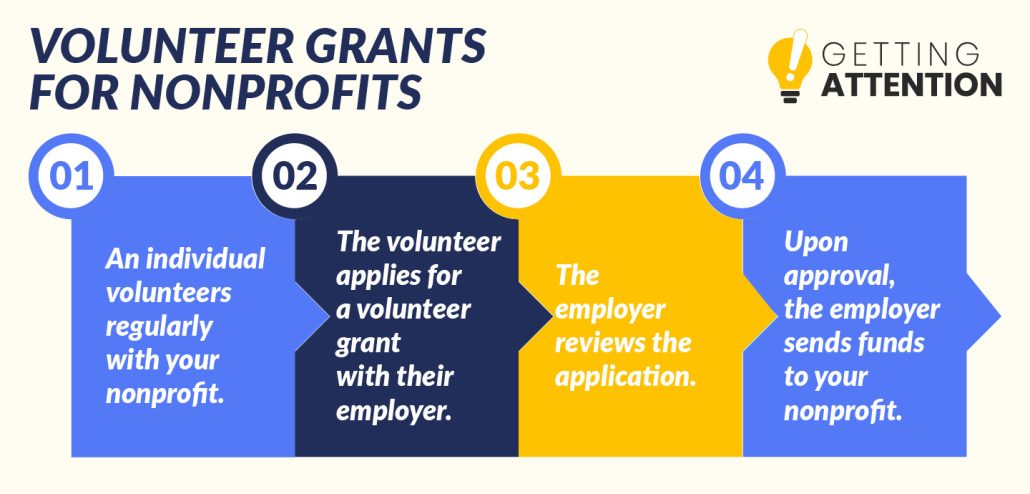
- Individuals volunteer. Volunteer grants start with regular volunteering. Be sure to keep accurate records of all of your volunteers’ hours since almost all volunteer programs award funding based on hours contributed.
- Volunteers apply for a volunteer grant. Help volunteers research their eligibility. Most employers will have relevant information in their employee handbooks or CSR software. However, nonprofits can streamline this process by investing in a volunteer grant database. These platforms house information on volunteer grant programs and can be searched by entering an employer’s name, allowing volunteers to find relevant information and start the application process in seconds.
- Employers review the applications. While different employers have different review processes, be prepared for employers to reach out to your nonprofit to confirm volunteer grant applications. For example, some organizations may want to speak with a volunteer supervisor to double-check the hours reported or ask questions about the volunteer’s contributions to ensure your nonprofit’s program meets their eligibility criteria.
- Employers fund your nonprofit. When a volunteer application is approved, your nonprofit can expect to receive payment from the employer or the employer’s CSR vendor, depending on their payout process. These payments may come shortly after the application’s approval or on a quarterly or even annual basis.
To learn about volunteer grants your volunteers may be eligible for, consider appending employer data to complete their profiles with crucial information such as their employer and job title. Then, reach out to notify them about this opportunity to increase their impact.
5. Establish a school partnership.
Over one in four college students and teenagers volunteer with nonprofits. Reach out to local middle schools, high schools, and colleges to recruit these young supporters for your organization.

Many schools promote volunteering by offering awards to those who reach a certain amount of service hours. Volunteering also allows students to build their resumes for college and job applications, make valuable connections, and develop leadership and teamwork skills.
To spread the word, ask schools to post flyers about your volunteer program, include a pitch for it in their email newsletter, or even set up a time for representatives from your nonprofit to visit classes and encourage students to get involved.
6. Build relationships with other nonprofit clubs and organizations.
There are plenty of community service-driven clubs and organizations with members more than willing to get involved in your work. The key to recruiting more supporters is to find those who are already likely to be passionate about your mission. Reach out to your local Kiwanis Club or Lions Club to see if they’re willing to circulate your volunteer opportunities among their members.
Additionally, consider local churches in your area. Be sure to share your nonprofit’s mission and impact alongside your volunteer needs, so people can understand just how their involvement can make a difference in their community.
7. Reconnect with past volunteers.
Consider reaching out to individuals who have volunteered with your organization in the past and encouraging them to get involved again. If you’ve made improvements to your volunteer program, you can send them an email explaining the program’s new aspects and invite them to return.
You can also send them a survey for feedback. This may provide important insights into what about your program, if anything, leads individuals to stop volunteering. Remember that in order for your volunteer recruitment efforts to pay off, you need to have measures in place to retain your volunteers’ support for the long term.
8. Leverage your staff members and board.
Your nonprofit’s staff and board members may have key connections within the community who would like to get involved with your nonprofit. By leveraging these relationships, you’ll be able to promote volunteering opportunities beyond your existing audience.
You can even create a relationship map that lays out all the connections that your board members have, from business associates to fellow alumni from universities they attended. This resource can be immensely beneficial in informing your volunteer recruitment tactics and donor outreach in the future.
9. Create a volunteer page on your website.
Your nonprofit’s website plays a central role for both your current supporters and those who are interested in learning more about your organization. Make it easy for visitors to discover how they can support your mission by creating a dedicated volunteer page that contains all the relevant details for signing up. Be sure to include:
- Descriptions of open opportunities
- A link to your signup form
- Compelling images of volunteers in action
- A list of FAQs
- Contact information for additional questions
- A volunteer grant database
Feeding America, for example, has a volunteer page that features a large image of volunteers in action. Front and center on the page, interested supporters can fill in their information to pledge to volunteer and find opportunities in their location.
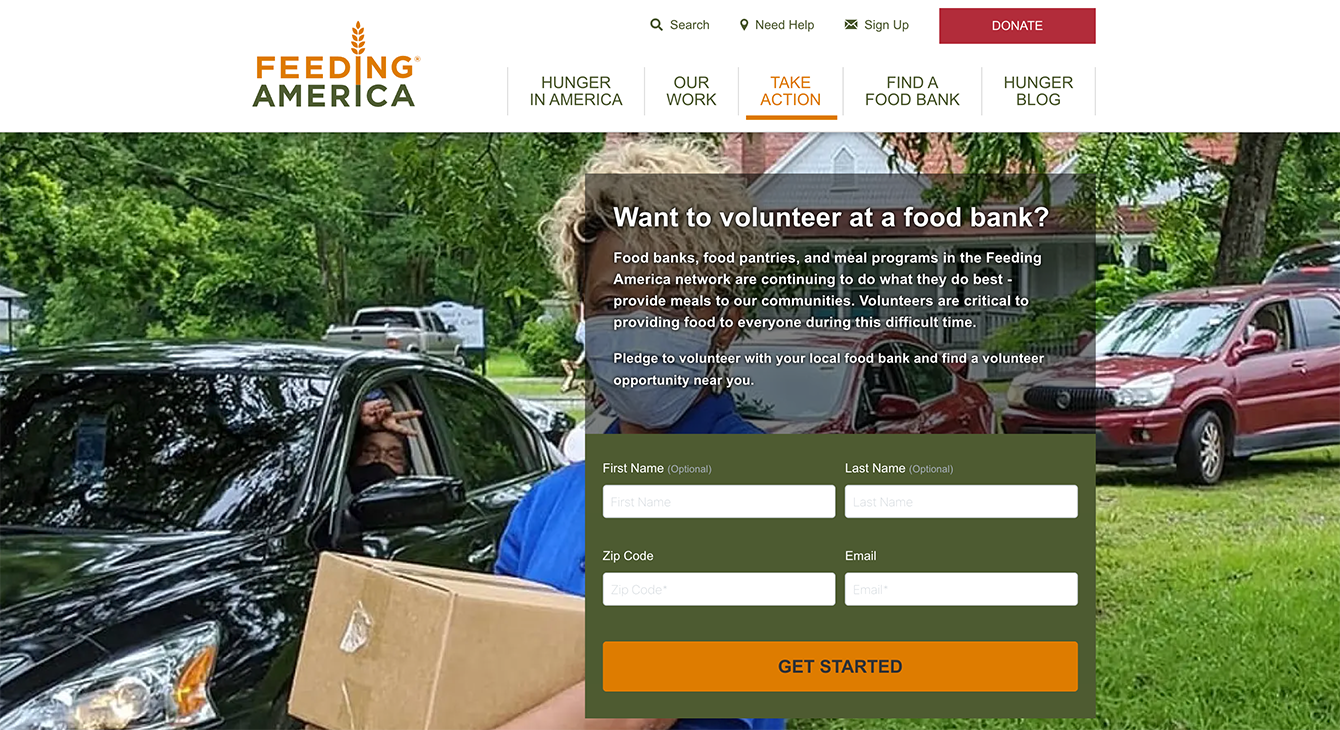
The easier the volunteer signup process is, the more success you’ll have with recruiting eager volunteers for your nonprofit’s cause.
10. Post on volunteer matching websites.
Get in front of people who are already on the lookout for volunteer opportunities by posting on volunteer matching sites. Some popular sites for volunteer recruitment include:
- VolunteerMatch. VolunteerMatch has connected 18 million volunteers with nonprofits who need their support. This website allows people to refine their search by inputting information such as mission category, skills, and distance, making it easy for those who are passionate about your organization’s cause to find the opportunities you have available.
- Catchafire. This website has matched volunteers on over 40,000 skills-based projects for nonprofits so far. Your organization can post volunteer job descriptions that require specific expertise, such as accounting or copywriting, and find qualified individuals to support your mission.
- Idealist. By creating an account on the website, your organization can post volunteer listings for free to reach Idealist’s 1.3 million monthly visitors.
- Create the Good. By registering for Create the Good, your nonprofit can post volunteer opportunities of all sizes and track volunteer participation in those opportunities.
Be sure that the volunteer job descriptions you post clearly outline the qualifications and expectations related to each position. This increases the chances you’ll find candidates with both the skills and the passion to enhance your nonprofit’s impact.
11. Reach out to local media outlets.
In addition to leveraging social media, Google ads, and volunteer matching websites, broaden your nonprofit’s reach by approaching local media outlets that may be willing to share your volunteer opportunities with their audiences. Consider reaching out to local:
- Newspapers
- Bloggers or podcasters
- TV stations
- Radio stations
According to the Federal Communications Commission, radio stations are legally required to operate in the “public interest” of their local communities. One way to demonstrate that they’re responding to the needs and interests of their community is to dedicate some airtime to nonprofits, allowing them to share their causes and direct listeners to their websites. This is an effective way to reach people who might not otherwise be exposed to your organization.
12. Provide a variety of volunteer opportunities.
Just as your nonprofit’s donors have varying preferences and connections to your cause, your volunteers will have their own strengths and interests. Therefore, be sure to provide a variety of opportunities that will appeal to everyone interested in volunteering with your organization.
While some of your volunteer positions may allow individuals to advance their specialized skills, for instance, you may also offer opportunities where people can develop their teamwork skills by working closely with other volunteers.
13. Prioritize accessibility.
Make your volunteer opportunities inclusive for people of all abilities by ensuring that locations are accessible to those who use mobility equipment and including a field in your volunteer signup form that asks whether the individual may need any accommodations to fulfill their role.
Furthermore, to provide a positive experience for all volunteers, consider factors such as transportation, childcare, and meals in advance. You may arrange for carpools or provide meals for volunteers on longer shifts to ensure that they can support your organization in a way that’s comfortable for them. Virtual volunteering opportunities can be another effective option, especially for supporters outside of your local area.
14. Consider micro-volunteering.
Micro-volunteering refers to offering volunteer opportunities that are more short-term and low-commitment so that even supporters with busy schedules can find ways to contribute to your nonprofit’s impact.
For instance, you can ask supporters to translate a document, sign an online petition, or make thank-you phone calls to donors. This can be a wonderful way to keep even the most time-pressed volunteers engaged with your organization for the long run.
15. Offer incentives to volunteer.
While 66% of volunteers get involved to make a difference in their communities, and 60% volunteer to contribute to a cause they care about, offering incentives can enhance volunteers’ experience with your nonprofit and keep them enthusiastic about supporting your work. Some common incentives to consider in your volunteer recruitment include:
- Branded merchandise, like t-shirts and hats
- Free food and drink
- Gift cards or baskets
- Social media shoutouts
These incentives can not only inspire more supporters to sign up as volunteers, but they can also serve as impactful volunteer appreciation ideas as well.
16. Recognize volunteers and ask for feedback.
Remember that determining how to recruit volunteers is only the start. Once you’ve found your volunteers, be sure to practice frequent recognition to retain their support for years to come. Send thank-you letters and share the specific impact of volunteers’ support so that they understand the importance of their contributions. These communications should:
- Be prompt. Follow up with volunteers within a few days after their experience to ensure that they feel valued for their time and effort.
- Be personalized. Show each supporter that you appreciate them as an individual to build a stronger, longer-lasting relationship with them.
- Specify impact. Your volunteers want to know that they’re making a difference by contributing to your organization. In your thank-you message, be clear and specific as to how their involvement made an impact on the lives of those you serve.
- Include images. Add relevant, compelling images or even videos to your thank-you’s to enhance your message and help volunteers visualize their impact.
- Encourage further action. In addition to appreciating your volunteers, it’s important to keep them invested in your mission by offering them more ways they can get involved in the near future.
Use this volunteer thank-you template as a springboard for creating impactful, personalized messages to your supporters:
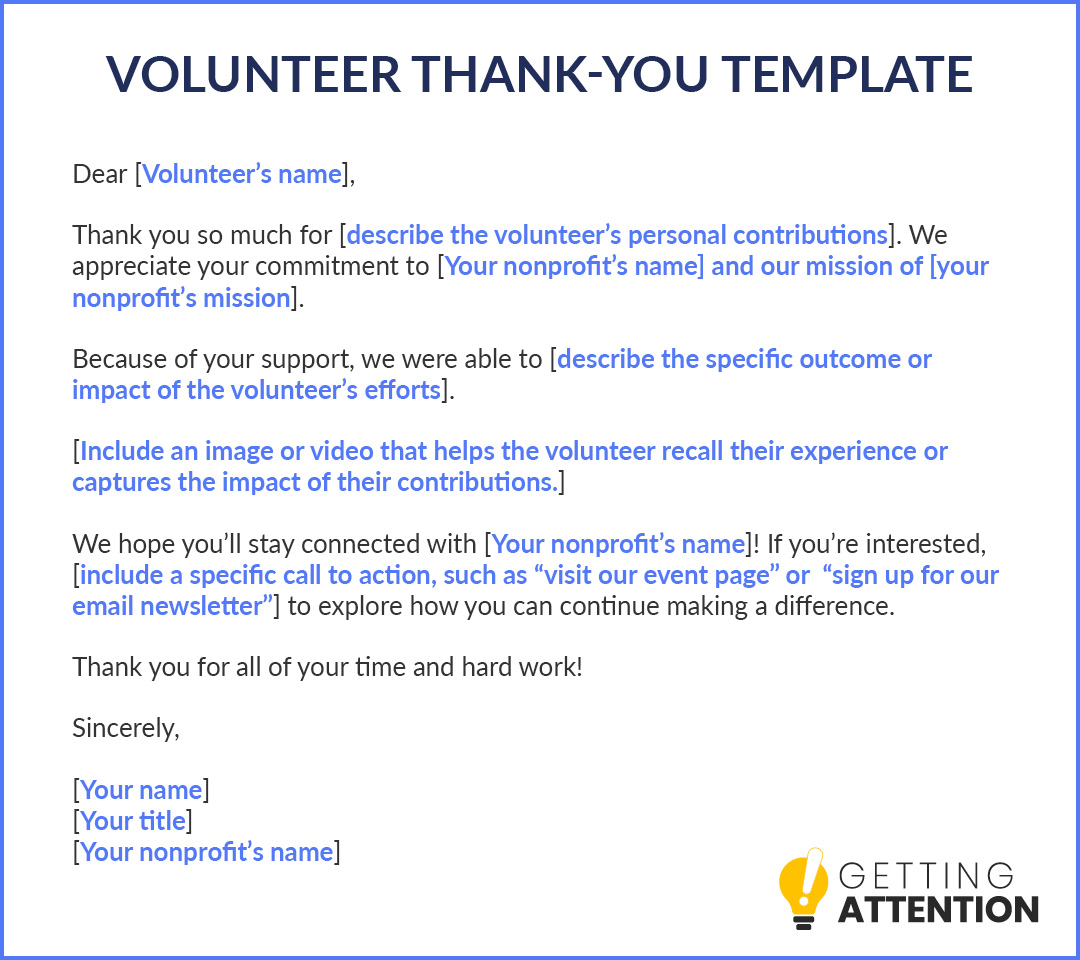
Furthermore, consider sending out surveys to gather direct feedback from volunteers after their involvement. This allows you to gauge their satisfaction with your organization and identify areas of improvement to boost your volunteer recruitment results moving forward.
17. Promote Volunteer Time Off
49% of individuals report that work commitments are their biggest obstacle to volunteering. This means there are many prospective supporters who would like to start volunteering or volunteer more but are unable to.
Fortunately, more businesses have become aware of this struggle and have come up with a solution: volunteer time off (VTO). VTO is paid time off employees can take specifically to volunteer. On average, most companies with VTO policies offer two or three days per year, but some organizations provide employees with an entire week they can take off for volunteering.
With VTO, employees can volunteer during normal business hours without sacrificing a paycheck or a much-needed vacation day. However, despite this upside, participation in VTO programs is often low due to a lack of awareness. Spread the word among your nonprofit’s supporters to earn more volunteers and ensure they’re taking full advantage of their employment benefits.
Be aware that, like volunteer grants, VTO programs often have requirements for who is eligible and what types of activities are applicable. A few common considerations include:
- Employee status. Some businesses only allow full-time employees to participate while others include those who work both part- and full-time. Eligibility might also depend on employee level. For example, some businesses might provide VTO to executive employees but not retail employees.
- Organization type. Volunteer grants often exclude specific types of nonprofits, like religious and political organizations. The same goes for VTO, and VTO may even be stricter about allowed activities to prevent employees from treating it like regular paid time off. If a volunteer lets you know they are using their VTO hours, keep track of what activities they are performing so you can verify with their employer if they reach out to you.
- Request date. When it comes to planned time off, most businesses prefer employees to let them know far in advance. Encourage supporters to review their accumulated VTO hours and request them well before shifts they would like to work. Additionally, some businesses don’t allow VTO hours to roll over, meaning employees need to take advantage of them before they’re gone.
Promote VTO to your entire supporter base. You might be surprised how many of them are eligible and able to put in more hours to help your nonprofit. In fact, 61% of businesses offer VTO programs!
You might even add information about VTO to your volunteer page to encourage prospective volunteers to check if they qualify. Plus, consider investing in a volunteer grant database that also provides information on VTO. This way, your volunteers will have a one-stop resource for all of the corporate volunteering information they need.
For more information on how to promote and leverage volunteer time off to recruit more volunteers, download Double the Donation’s free guide to VTO.
Wrapping Up
Recruiting high-quality supporters is essential to your nonprofit’s long-term success. By creating a memorable and rewarding experience for all of your volunteers, you’ll be able to build a strong, loyal volunteer base that sustains your organization into the future.
To learn more about promoting your volunteer opportunities and securing more support, explore these additional resources:
- Digital Marketing for Nonprofits Made Easy: A Helpful Guide. Get started with crafting your nonprofit’s digital marketing strategy using the tips in this guide.
- How to Apply for Google Grants: Get Approved in 5 Easy Steps. Ready to start making the most of the Google Ad Grants program? Follow these five easy steps to apply.
- Demystifying the Google Ad Grants Website Policy: A Guide. A high-quality website is just as important for volunteer recruitment as it is for qualifying for the Google Ad Grants program. Explore the program’s website requirements in this guide.







